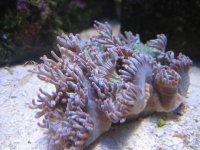Quote:
As a "content" provider (writing, photographs) in the ornamental aquatics interest (hobby, business, sciences) I’m faced with
answering queries about "trouble organisms" on a constant basis... As a real "old timer" who’s time in marine husbandry
spans its modern advent (yep, back to Robert P.L.
Straughan) to the present, I have seen trends, topics and fads come and go (e.g. both cycles of sugar as salt mix...
remember Magic Ocean?).
Incredulously, certain aspects of the trade have persisted... I would have never believed the insidious practice of cyanide
poisoning would make it past the millennium, let alone spread from the Philippines to parts of Indonesia...
And livestock... Folks are STILL buying/trying Moorish Idols (Zanclus canescens), Pinnatus Batfish (Platax pinnatus)
and Ribbon Moray Eels (Rhinomuraena spp.)... though these (and other fish species used extensively) have dismal survival
records; more than 99% dying within a few months of wild collection...
And fishes aren’t the only "ridiculous ongoing examples of poor choice"... Back in the fifties and sixties, what was the most
popular genus of corals used in the hobby? Goniopora spp., aka Flower Pot Corals... and still in number two popularity
(Green and Shirley, 1999)... and is still a very poor choice... yes, rating my worst of three rankings (a three) with more
than half dying within three months of gathering off the reef.
Which leads us to the topic of this essay, the
third most commonly available scleractinian species, Elegance Coral, Catalaphyllia jardinei. Though writers from
Veron (1986) to Fatherree (1999) rate this species as "excellent" for aquarium use, more than half of them perish
within a couple of months. My purpose here should be obvious: to make consumers aware of the odds they face in
selecting this reef-building stony coral, and to increase the folks who decide to invest in this species chances of
keeping theirs alive by providing natural history and husbandry information. To wit: this species does not live in
sterile, nutrient-deprived settings... but in the wild in muddy, mucky areas semi-buried in the substrate... sometimes in the
shallows of nearshore, other times at the base of reef slopes at depths of 20 meters or more.
-Robert M. Fenner
Wetwebmedia.com/
Here is the link, if you want to read further:
http://www.wetwebmedia.com/elegance.htm





